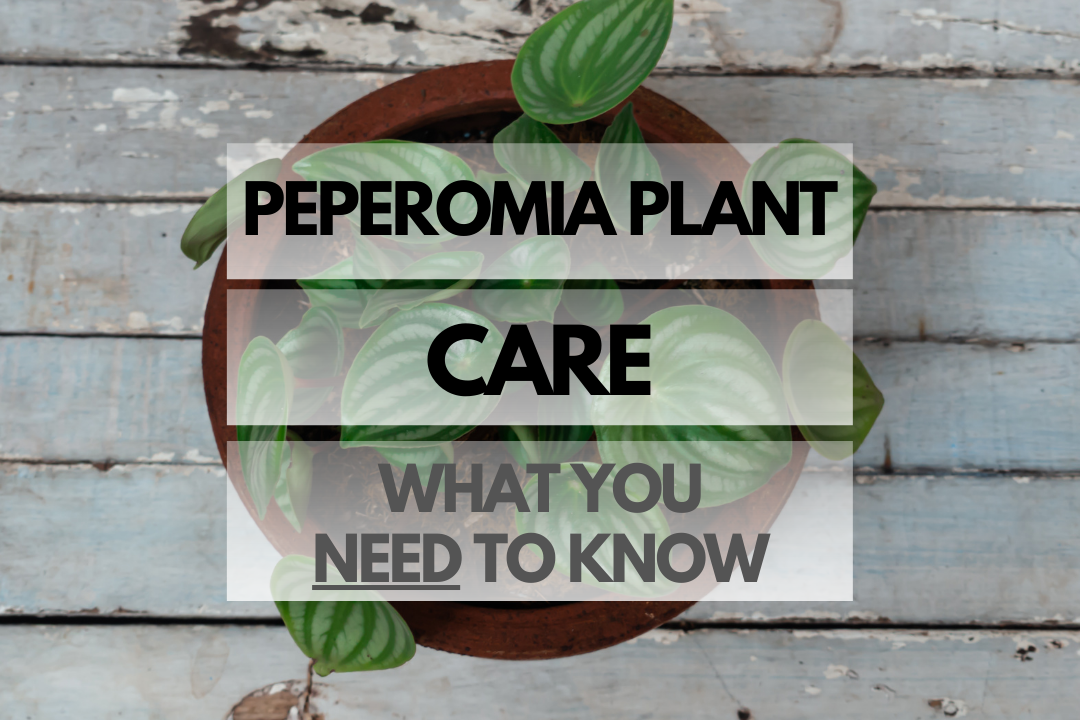Peperomia plants are popular houseplants known for their attractive foliage and easy-care nature. With their wide variety of leaf shapes, colors, and textures, they make excellent additions to any indoor plant collection. In this guide, we’ll explore everything you need to know about Peperomia plant care, from sunlight requirements to common problems and more!
Peperomia Care Guide
Quick Reference Table: Caring for Peperomia
| Aspect | Details |
|---|---|
| Sunlight | Bright, indirect light |
| Soil | Well-draining, peat-based potting mix |
| Watering | Allow the top inch of soil to dry out between waterings |
| Pruning | Remove dead or yellowing leaves; pinch back to maintain shape |
| Temperature | 60-80°F (15-27°C) |
| Common Problems | Overwatering, pests, leaf drop |
Peperomia Sunlight: Do They Need It and How Much?
Peperomia plants thrive in bright, indirect light. Direct sunlight can scorch their delicate leaves, so it’s best to place them near a bright window with filtered light or behind sheer curtains. Too little light can lead to leggy growth and dull foliage, so make sure your Peperomia gets sufficient light for optimal growth and vibrant leaf colors.
Peperomia Soil Tips
Peperomias prefer a well-draining, peat-based potting mix. A mix combining equal parts peat moss, perlite, and vermiculite works well for these plants. It’s essential to ensure that the soil drains well to avoid waterlogged roots, which can lead to root rot and other issues.
Peperomia Watering and Frequency
Watering is a crucial aspect of Peperomia care. These plants are semi-succulent and can store water in their thick leaves, making them somewhat drought-tolerant. Allow the top inch of soil to dry out between waterings, and then water thoroughly, allowing the excess water to drain away. Overwatering can cause root rot and lead to leaf drop, so it’s essential to avoid soggy soil.
Pruning Peperomia Properly
Pruning your Peperomia helps maintain its shape and encourages bushier growth. Regularly remove any dead or yellowing leaves to keep your plant looking its best. If your Peperomia becomes leggy or too tall, pinch back the growing tips to encourage branching and a more compact form.
Optimal Peperomia Temperature: Can They Tolerate the Cold?
Peperomias prefer temperatures between 60-80°F (15-27°C). They can tolerate short periods of colder temperatures, but prolonged exposure to cold drafts or temperatures below 50°F (10°C) can cause leaf drop and other issues. It’s best to keep your Peperomia away from drafty windows, doors, or air conditioning vents during the colder months.
Common Peperomia Problems
Overwatering
One of the most common issues with Peperomia plants is overwatering, which can lead to root rot and leaf drop. To avoid overwatering, ensure that your plant’s soil is well-draining and allow the top inch of soil to dry out between waterings.
Pests
Peperomias can occasionally be affected by pests such as spider mites, mealybugs, and whiteflies. Inspect your plant regularly for any signs of infestation, and treat promptly with insecticidal soap or neem oil if necessary.
Leaf Drop
Leaf drop in Peperomia plants can be caused by various factors, including overwatering, cold temperatures, or insufficient light. To prevent leaf drop, provide your Peperomia withthe appropriate care, including proper watering, stable temperatures, and sufficient indirect sunlight.
Peperomia Outdoors vs Indoors
Peperomia plants can be grown both indoors and outdoors, depending on the climate and conditions. However, they are primarily grown as indoor plants due to their preference for stable temperatures and controlled environments. Here’s a breakdown of the pros and cons of growing Peperomia plants indoors and outdoors:
| Location | Pros | Cons |
|---|---|---|
| Indoors |
|
|
| Outdoors |
|
|
Best Pots for Peperomia
Selecting the right pot for your Peperomia plant is essential for good growth and overall health. The best pots for Peperomia plants are those with drainage holes to help prevent overwatering and root rot. Choose a pot made from a breathable material, such as terracotta, to further improve drainage and aeration. Ensure the pot is appropriately sized for your plant, as too large of a pot can retain excess moisture and lead to root issues.
Peperomia Facts
Peperomia Benefits
Peperomia plants offer various benefits that make them a great addition to your indoor plant collection:
- Air purification: Peperomia plants help remove pollutants, such as formaldehyde and benzene, from the air, improving indoor air quality.
- Low maintenance: These plants are easy to care for, making them perfect for beginners and busy plant owners.
- Attractive foliage: With their wide variety of leaf shapes, colors, and textures, Peperomia plants add visual interest and can serve as a focal point in any room.
- Compact size: Most Peperomia varieties remain relatively small, making them ideal for small spaces and tabletop displays.
Growth Rates: How Fast Do They Grow?
Peperomia plants are generally slow to moderate growers, depending on the variety and growing conditions. With proper care, most Peperomias will reach their full size within 2-3 years. Some varieties may grow faster than others, but overall, these plants are not known for rapid growth.
Peperomia Lifespan
With proper care, Peperomia plants can live for several years. The exact lifespan of a Peperomia plant depends on factors such as the variety, growing conditions, and overall care. However, with good care practices and optimal conditions, these plants can continue to thrive and provide enjoyment for many years.
Are Peperomia Plants Safe?
Peperomia plants are generally considered safe and non-toxic for humans and pets. However, it is still a good idea to keep these plants out of reach of children and pets, as ingesting large quantities of any plant material can cause digestive upset.
Peperomia Flowers
While Peperomia plants are primarily known for their attractive foliage, they do produce small, inconspicuous flowers on spikes called inflorescences. These flowers are usually green or white, and although they are not particularly showy, they add a subtle charm to the plants overall appearance.
Peperomia Types and Varieties
There are over 1,000 species of Peperomia, with numerous cultivars and hybrids available. Here are a few popular varieties:
Peperomia caperata
Also known as Ripple Peperomia, this variety features heart-shaped, deeply ridged leaves with a wrinkled texture. The leaves can be green, red, or silver, depending on the cultivar.
Peperomia obtusifolia
Commonly known as Baby Rubber Plant, this variety has thick, glossy, oval-shaped leaves that resemble a rubber plant. The leaves can be green or variegated with white or yellow markings.
Peperomia argyreia
Also called Watermelon Peperomia, this variety is known for its striking, oval-shaped leaves with a watermelon-like pattern of green and silver stripes.
Peperomia prostrata
Commonly referred to as String of Turtles, this trailing variety features small, round, patterned leaves and is ideal for hanging baskets or cascading over the edge of a container.
Peperomia Pros and Cons
| Pros | Cons |
|---|---|
|
|
Peperomia Cost
Peperomia plants are generally affordable, with most varieties costing between $5 and $20, depending on the size and type. Rarer varieties or larger specimens may be more expensive.
Where to Buy Peperomia Plants
Peperomia plants can be found at local nurseries, garden centers, and big box stores. They are also available for purchase online through various plant retailers and marketplaces, such as Etsy, Amazon, and specialized online plant shops.
Is Peperomia Propagation in Water Possible?
Yes, Peperomia plants can be propagated in water. To do this, take a healthy leaf or stem cutting from the parent plant and place it in a container of clean water. Replace the water every few days to prevent bacterial growth, and within a few weeks, you should see roots forming. Once the roots are well-developed, you can transfer the cutting to a pot with well-draining soil.
Additional Resources
- Missouri Botanical Garden: Peperomia Plant Profile
- Facebook Group: Peperomia Lovers
- Gardeners’ World: How to Grow Peperomias
FAQ for Peperomia Care
Are Peperomia plants toxic to cats?
No, Peperomia plants are generally considered non-toxic to cats.
Are Peperomia plants toxic to dogs?
No, Peperomia plants are generally considered non-toxic to dogs.
Are Peperomia plants toxic to kids?
No, Peperomia plants are generally considered non-toxic to humans, including children. However, it is still a good idea to keep plants out of reach of small children, as ingesting large quantities of any plant material can cause digestive upset.
How tall do Peperomia plants get?
Most Peperomia plants remain relatively small, with a height of 6-12 inches (15-30 cm) depending on the variety.
Can Peperomia plants live outside?
Peperomia plants can be grown outside in temperate climates, but they are primarily grown as indoor plants. They thrive in the controlled environment of a home and may struggle with fluctuating temperatures and humidity levels outdoors.
Are Peperomia plants poisonous?
No, Peperomia plants are generally considered non-toxic to humans and pets.

